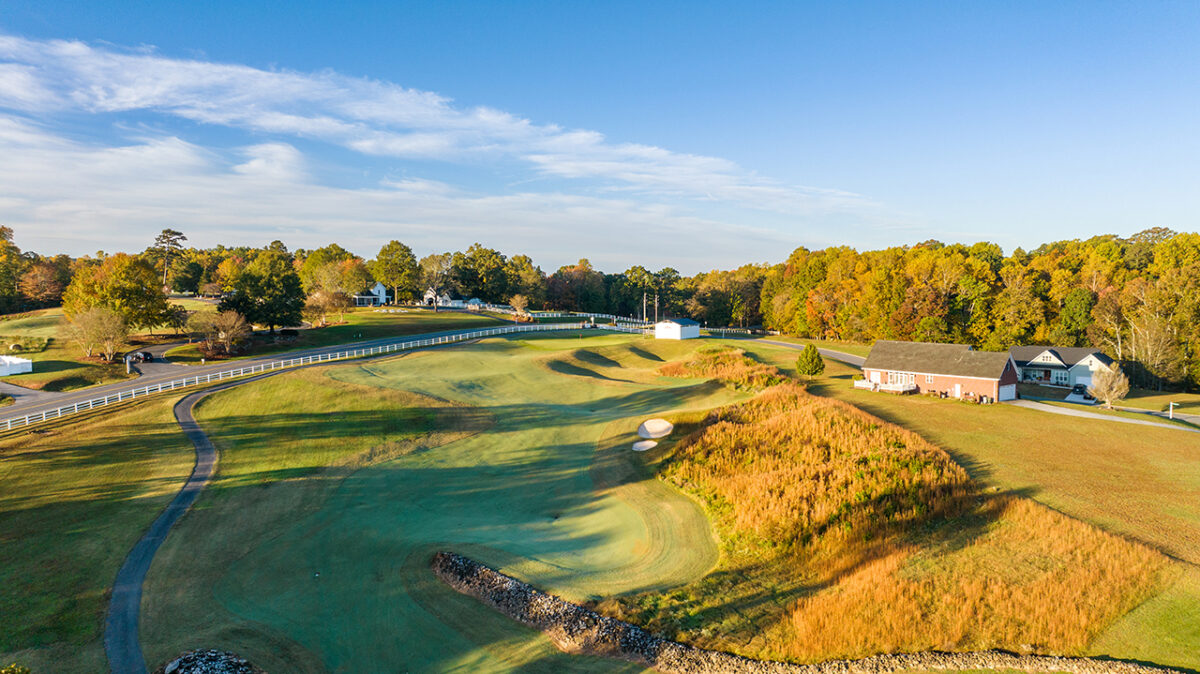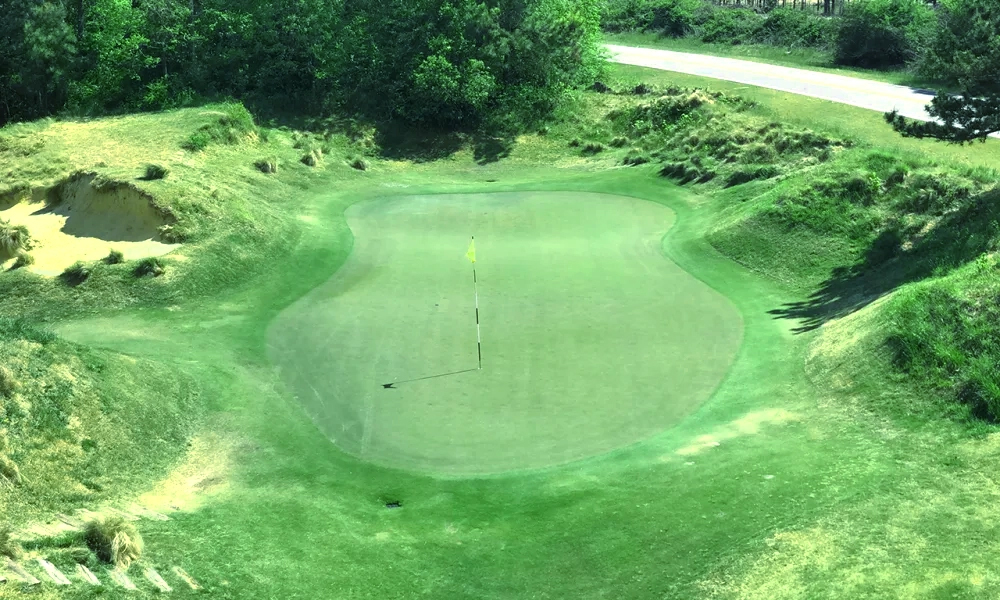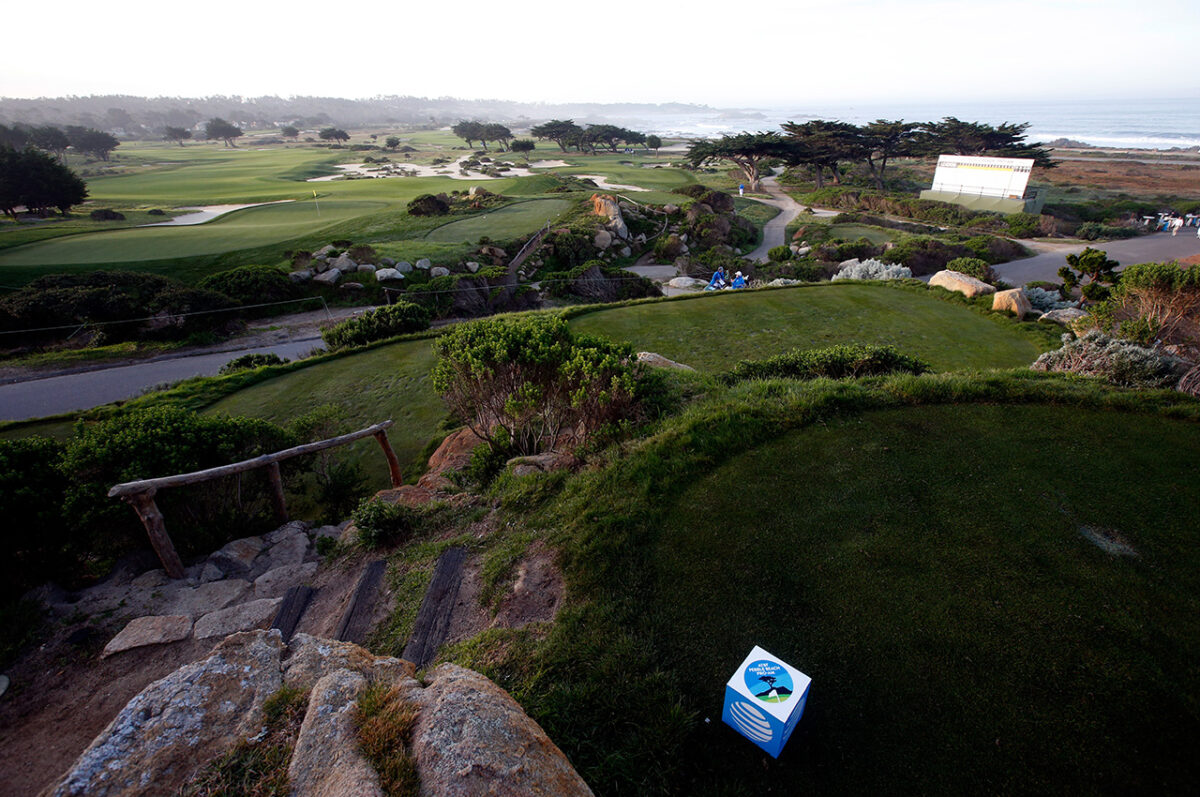Quirky. Unusual. Remarkable. Bizarre. Artistic. Surreal. Unorthodox. Wild. Weird. Polarizing. Unique.
All those descriptions and plenty more have been used in recent decades to describe the golf courses designed by the late Mike Strantz, whose layouts might best be described as fun for players looking for something completely different, classical orthodoxy be damned.
Having sharpened his pencil as a design associate to Tom Fazio, Strantz created or renovated only nine courses that bear his name as lead designer, most of them in his native Carolinas or nearby Virginia. He passed away in 2005 at the age of 50, a victim of cancer. A hands-on designer, he would spend weeks walking sites or exploring on horseback with a can of spray paint to mark features he either wanted to incorporate or build into the landscape.
Trained in studio art, Strantz would hand-sketch in great detail each hole of a course before it was built, then lead his team of shapers in making his art come to life. Those golf holes often include nearly impossible-to-reach hole locations, wild bunkering, extreme greens, eye-popping mounding and dramatic slopes – all elements beloved by a growing cadre of adventure-seeking golfers.

Imagine their despair when one of Strantz’s courses falls into disrepair, as happened with several of his layouts, especially in the wake of an industry-wide financial struggle starting in 2008.
Tot Hill Farm Golf Club in Asheboro, North Carolina, is one such example, having opened in 2000 but its former operators lacking the revenues to maintain and present the course as Strantz intended. Trees choked out fairways and strategic lines, bunker edges crumbled and playing surfaces suffered in recent years.
But that all started to change early in 2022 when native South Carolinian Pat Barber bought the course and amenities. Already the owner of two courses nearer the coast in the state – The Links at Stono Ferry and The Plantation Course at Edisto – Barber recognized an opportunity to restore Tot Hill Farm as acclaim for Strantz’s designs continues to grow, especially with the increasing popularity of the nearby Strantz-designed Tobacco Road.
https://www.instagram.com/reel/Cyquka5OdVh/?igsh=MTJua2I5cmYwM2Viag==
“Working with the course itself, the overall natural beauty, that really attracted us to the property,” said Greg Wood, the director of operations for all three of Barber’s course. “I’ve seen Mike in video interviews saying that he felt this was one of the best pieces of properties that he got to use in his design work. All we could see was the potential.”
A restoration of Tot Hill began in the spring of 2022, and it’s easy now to say this layout has rejoined the brief list of can’t-miss Strantz designs. It would be oversight for any Strantz fan to head to the nearby golf mecca of Pinehurst or the Carolina coast and miss the incredible amount of work that has gone into turning around the rolling and rollicking Tot Hill Farm.
The site always held so much promise. With more than 250 of feet of elevation change and boulders littering the landscape, the holes frequently heave up, down and across rambling creeks, the greens often perched perfectly into hillsides. The whole place just needed somebody to come along and scrape away 20 years of hard times.
More than 1,500 trees were cleared, re-establishing fairway widths and playing lines. Several arbitrary bunkers that weren’t part of Strantz’s design were removed, and his original traps were reinvigorated. Players must plot their way around them, and with the corridors having been widened, there are choices available instead of the previous condition of bowling alley tightness between the branches that choked out shot selection as well the health of the turf.

The greens were rebuilt and surfaced with Prizm Zoysia, a new strain of grass that promises to withstand Asheboro’s cold winters that are too frigid for Bermuda grass and the hot summers that are too steamy for bent grass to thrive. The new surfaces are still growing in, but during a late-fall round they had started to pick up some steam and promise even more to come. An interesting fact about this strain of zoysia: The grass covering is so dense, it’s almost impossible to leave a pitch mark on a green, and that same characteristic is promising for the preferred firm and bouncy conditions.
Wood is quick to call all the work a restoration effort, not a renovation. Crews worked in painstaking detail to put back what Strantz had intended, frequently using the architect’s hand-drawings – those sketches now decorate the new clubhouse that has been created in an idyllic old farmhouse, replacing a trailer that served that function before. The restorers also had access to more than 40 hours of construction video featuring the original design.
“Over time, we figured out how it’s supposed to be,” Wood, a longtime PGA of America member, said of Strantz’s design which is a likely contender for future inclusion among Golfweek’s Best public-access courses in North Carolina. “And for somebody like me, figuring out the puzzle and the why – even now, as I walk a hole, I’ll find something new.”
Playing Tot Hill is a mixture of various wows and walking on eggshells, so far as the scorecard goes. Strantz clearly wasn’t interested in building easy golf, and several holes prove Tot Hill is no exception. Much like Tobacco Road just more than an hour’s drive away, Tot Hill Farm in particular punishes wayward approach shots, the greens frequently seeming to shrug off approach shots with a “not-good-enough” attitude.

Strantz included sections on several greens that might prove inaccessible to all but a tour player’s towering precision. The skinny back right hole location on the par-3 third hole, hidden behind sand aside a hill with a creek just steps off the back, will likely prove to an average player to be a no-go.
Another thrilling tear-jerker is the drop-down rear portion of the 10th green before the putting surface tumbles steeply downhill to form a double green with No. 12, the center portion now covered in tight fringe instead of even lower green-height zoysia. Just try and hit the back right portion of the par-3 13th green, hidden beyond a stream and behind a boulder.
There are other oddities. For example, several tees are routed in such a way that players must double back and play directly across previous holes, as noted on No. 4 and possibly No. 14 if a restored tee atop a hill is put into play. Such routing can create odd bottlenecks, and while it might be manageable on a private course with limited rounds, it could prove problematic on a packed day of public play.
These and other examples might cause a facial tic among some classic architecture purists. But with plenty of width now available, a thoughtful golfer can find a way around all the trouble, choosing to play to safer sections of the greens on each of the examples above, then putting the putter to use in search of par. All around Tot Hill Farm is danger to a golfer’s score, and close by is a safer route. It’s up to the golfer to put aside ego and expectation, accepting the limitations of what Strantz offered in some places while pouncing on opportunities when friendlier hole locations are identified. There are birdies out there.
In short, it’s all about the strategy. And that might begin even before the first tee shot, as the frustrations of Tot Hill Farm’s difficulties most greatly affect stroke play. This could be one of the best match-play courses in the U.S., for those who embrace that format.
“If you come back and play this course several times, the thing you’ll find intriguing is there are multiple ways to play every hole,” Wood said. “When I first took on the project, I didn’t really understand that. But as I continue on and on with it, I find that very intriguing and I’m enjoying it more and more.”

The layout reopened in the fall of 2023, and bookings are picking up speed for 2024. Green fees are relatively low, currently $70 through the winter with a peak of $125 planned for the new year – carts are an extra $25. Tot Hill Farm is also appearing as a packaged option around Pinehurst, which is less than an hour to the south via Interstate 74.
The best way to enjoy Strantz’s work at Tot Hill Farm might be to race across the Carolinas, playing Tot Hill and Tobacco Road in North Carolina before heading to the coast to sample Strantz’s Caledonia Golf and Fish Club and True Blue near Myrtle Beach, South Carolina. For an adventurous group of golfers, that would be an unforgettable trek.
And it’s just such players that are most likely to book and rebook rounds at Tot Hill Farm. It’s not a classical layout, and it might be too severe in places to tickle every player’s fancy. But the recent surge in popularity for Strantz courses, particularly on Instagram and X-the-former-Twitter, will surely help Tot Hill’s operators fill the tee sheets.
“We think the adventure-style golf course, Mike was kind of at the forefront of it, and we feel like we’re bringing something that was almost forgotten back to people,” Wood said. “We feel really fortunate to be a part of it. Unfortunately, Mike passed away way too soon. For us to be caretakers of a Mike Strantz course, we find that to be a real honor.”
Here are more photos of the course:



